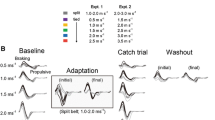The decisive role of sensory input in the initiation and modulation of locomotion has been demonstrated repeatedly. One approach to studying this input is provided by the split treadmill paradigm. We report here a comparative analysis of the walking of decerebrated cats on a split treadmill with belts moving not only at different speeds (differing by a factor of three), but also in different directions (forward and backward). The two limbs were shown to operate reciprocally in this mode of locomotion, as did the flexor and extensor muscles of each limb. Two main stepping strategies were identified: for each step of the limb walking on the slow treadmill belt, the limb walking on the fast belt carried out either one step (the 1:1 strategy) or two steps (the 1:2 strategy); strategies could alternate. The results obtained here suggest persistence of the integration of the locomotor networks of the two limbs despite significant mismatch of their sensory inputs.
Similar content being viewed by others
References
Akay, T., McVea, D. A., Tachibana, A., and Pearson, K. G., “Coordination of fore and hind leg stepping in cats on a transversely-split treadmill,” Exp. Brain Res., 75, No. 2, 211–222 (2006).
Buford, J. A., Zernicke, R. F., and Smith, J. L., “Adaptive control for backward quadrupedal walking. I. Posture and hindlimb kinematics,” J. Neurophysiol., 64, No. 3, 745–755 (1990).
Choi, J. T. and Bastian, A. J., “Adaptation reveals independent control networks for human walking,” Nat. Neurosci., 10, No. 8, 1055–1062 (2007).
Forssberg, H., Grillner, S., Halbertsma, J., and Rossignol, S., “The locomotion of the low spinal cat. II. Interlimb coordination,” Acta Physiol. Scand., 108, No. 3, 283–295 (1980).
Frigon, A., “The neural control of interlimb coordination during mammalian locomotion,” J. Neurophysiol., 117, No. 6, 2224–2241 (2017).
Frigon, A., Desrochers, E., Thibaudier, Y., et al., “Left-right coordination from simple to extreme conditions during split-belt locomotion in the chronic spinal adult cat,” J. Physiol., 595, No. 1, 341–361 (2017).
Gerasimenko, Y., Musienko, P., Bogacheva, I., et al., “Propriospinal bypass of the serotonergic system that can facilitate stepping,” J. Neurosci., 29, No. 17, 5681–5689 (2009).
Halbertsma, J., “The stride cycle of the cat: the modelling of locomotion by computerized analysis of automatic recordings,” Acta Physiol. Scand. Suppl., 521, 1–76 (1983).
Kim, S. A., Heinze, K. G., and Schwille, P., “Fluorescence correlation spectroscopy in living cells,” Nat. Methods, 4, No. 11, 963–973 (2007).
Kuczynski, V., Telonio, A., Thibaudier, Y., et al., “Lack of adaptation during prolonged split-belt locomotion in the intact and spinal cat,” J. Physiol., 595, No. 17, 5987–6006 (2017).
Kulagin, A. S. and Shik, M. L., “Interaction of symmetrical limbs in controlled locomotion,” Biofizika, 15, No. 1, 164–170 (1970).
Lyakhovetskii, V., Merkulyeva, N., Gorskii, O., and Musienko, P., “Simultaneous bidirectional hindlimb locomotion in decerebrate cats,” Sci. Rep., 11, No. 1, 3252 (2021).
Maxwell, D. J. and Soteropoulos, D. S., “The mammalian spinal commissural system: properties and functions,” J. Neurophysiol., 123, No. 1, 4–21 (2020).
Merkulyeva, N., Veshchitskii, A., Gorsky, O., et al., “Distribution of spinal neuronal networks controlling forward and backward locomotion,” J. Neurosci., 38, No. 20, 4695–4707 (2018).
Musienko, P., Courtine, G., Tibbs, J. E., et al., “Somatosensory control of balance during locomotion in decerebrated cat,” J. Neurophysiol., 107, No. 8, 2072–2082 (2012).
Pearson, K. G. and Duysens, J., “Function of segmental reflexes in the control of stepping in cockroaches and cats,” in: Neural Control of Locomotion. Advances in Behavioral Biology, Herman, R. M. et al. (eds.), Springer, Boston, MA (1976), pp. 519–537.
Reisman, D. S., Block, H. J., and Bastian, A. J., “Interlimb coordination during locomotion: What can be adapted and stored?” J. Neurophysiol., 94, No. 4, 2403– 2415 (2005).
Rossignol, S., Dubuc, R., and Gossard, J.-P., “Dynamic sensorimotor interactions in locomotion,” Physiol. Rev., 86, No. 1, 89–154 (2006).
Shapkova, E. Y., “Spinal locomotor capability revealed by electrical stimulation of the lumbar enlargement in paraplegic patients,” in: Progress in Motor Control, Latash, M. and Levin, M. (eds.) Human Kinetics Publishers (2004), pp. 253–289.
Shkorbatova, P. Y., Lyakhovetskii, V. A., Merkulyeva, N. S., et al., “Prediction algorithm of the cat spinal segments lengths and positions in relation to the vertebrae,” Anat. Rec., 302, No. 9, 1628–1637 (2019).
Thelen, E., Ulrich, B. D., and Niles, D., “Bilateral coordination in human infants: stepping on a split-belt treadmill,” J. Exp. Psychol. Hum. Percept. Perform., 13, No. 3, 405–410 (1987).
Veshchitskii, A. A., Lyakhovetskii, V. A., Gorskii, O. V., et al., “What can bidirectional stepping can tell about central pattern generators?” Zh. Vyssh. Nerv. Deyat., 72, No. 2, 248–262 (2022).
Yanagihara, D., Udo, M., Kondo, I., and Yoshida, T., “A new learning paradigm: adaptive changes in interlimb coordination during perturbed locomotion in decerebrate cats,” Neurosci. Res., 18, No. 3, 241– 244 (1993).
Yang, J. F., Lamont, E. V., and Pang, M. Y., “Split-belt treadmill stepping in infants suggests autonomous pattern generators for the left and right leg in humans,” J. Neurosci., 25, No. 29, 6869–6876 (2005).
Author information
Authors and Affiliations
Corresponding author
Additional information
Translated from Zhurnal Vysshei Nervnoi Deyatel’nosti imeni I. P. Pavlova, Vol. 73, No. 1, pp. 76–87, January–February, 2023.
Rights and permissions
Springer Nature or its licensor (e.g. a society or other partner) holds exclusive rights to this article under a publishing agreement with the author(s) or other rightsholder(s); author self-archiving of the accepted manuscript version of this article is solely governed by the terms of such publishing agreement and applicable law.
About this article
Cite this article
Lyakhovetskii, V.A., Shkorbatova, P.Y., Gorskii, O.V. et al. Stepping in Decerebrated Cats at Simultaneously Different Speeds on a Split Treadmill. Neurosci Behav Physi 53, 873–881 (2023). https://doi.org/10.1007/s11055-023-01480-y
Received:
Accepted:
Published:
Issue Date:
DOI: https://doi.org/10.1007/s11055-023-01480-y




